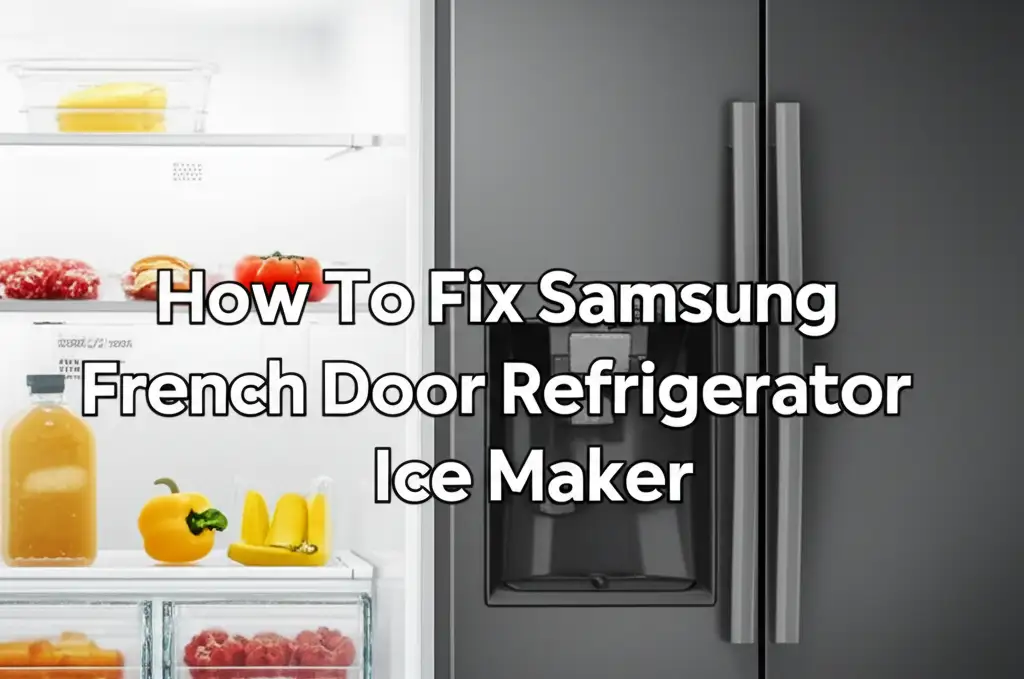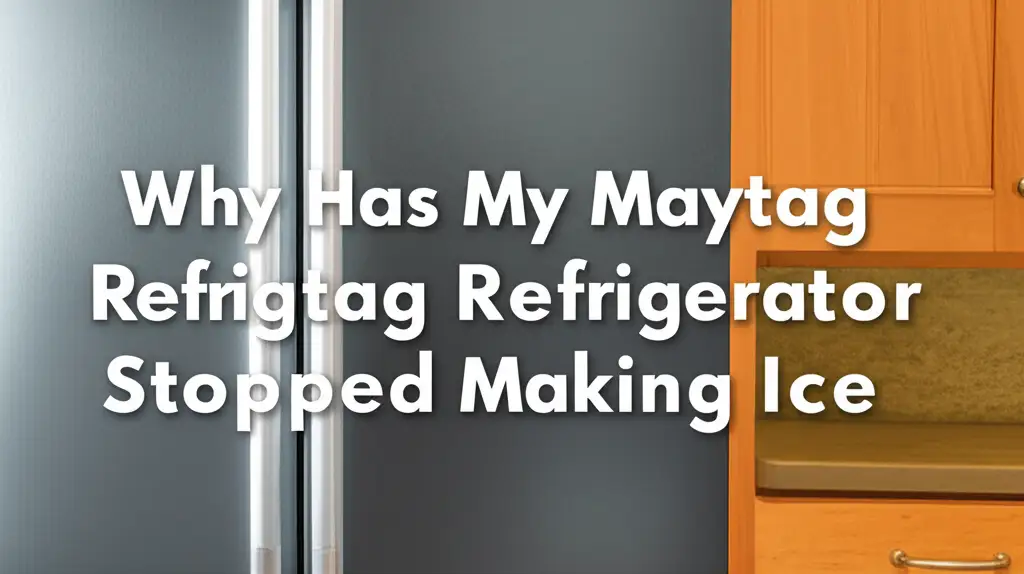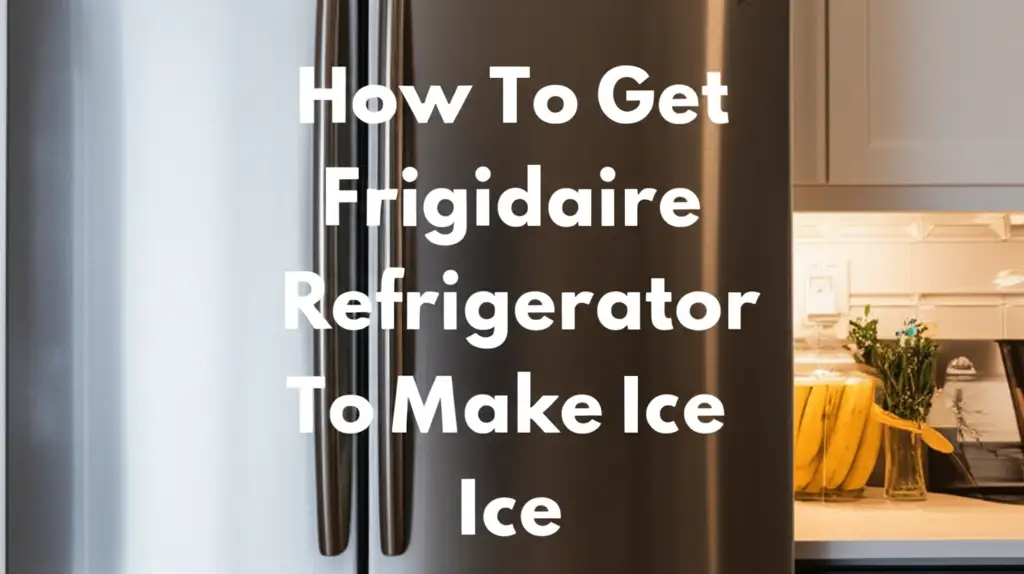· Todd Martin · Appliance Repair · 16 min read
How To Fix Samsung French Door Refrigerator Ice Maker

How to Fix Samsung French Door Refrigerator Ice Maker Issues
There is nothing quite as frustrating as needing ice and finding your Samsung French Door refrigerator ice maker is not working. You expect cool, refreshing ice, especially on a hot day. When the ice maker stops producing, it disrupts your daily routine. This issue is common with many refrigerators, including Samsung French Door models.
Many reasons can cause an ice maker to stop working. This includes simple fixes like a clogged water line or a tripped switch. Sometimes, it involves more complex component failures. I know the feeling of a broken ice maker. It is annoying to buy bags of ice when your appliance should be making it for you. This article provides step-by-step guidance. We will help you diagnose and fix Samsung French Door refrigerator ice maker problems. You will learn to identify common culprits and apply effective solutions. This guide will help you get your ice maker running smoothly again.
Takeaway
- Check Basic Connections: Ensure the refrigerator has power and the water supply is on.
- Inspect for Ice Buildup: Defrost the ice maker and surrounding areas if ice is blocking parts.
- Verify Water Supply: Change the water filter and check the water line for clogs or kinks.
- Test Components: Look for issues with the fill tube, auger motor, or ice maker module.
- Reset the System: Perform a simple power cycle to clear minor glitches.
- Consider Professional Help: Call a technician for complex electrical or component failures.
To fix a Samsung French Door refrigerator ice maker, first check the water supply and ensure the ice maker arm is down. Defrost any ice buildup inside the ice maker bin and around the fill tube. Reset the ice maker by turning off and on the refrigerator. Replace the water filter if it is old.
Understanding Your Samsung French Door Ice Maker
Before we dive into fixes, it helps to know how your Samsung French Door ice maker works. Most Samsung French Door refrigerators have the ice maker in the freezer compartment. Some newer models may have it in the fresh food section. Water flows into a small tray. A heating element then freezes this water into cubes. Once frozen, a small motor pushes the ice cubes out into a storage bin. Sensors detect when the bin is full or empty, controlling the ice production cycle.
Knowing this process helps in troubleshooting. If any part of this cycle fails, the ice maker stops working. For example, a blockage in the water line means no water reaches the tray. An issue with the motor means ice cannot be ejected. A faulty sensor might stop production prematurely. We will look at each part in more detail. This will help you pinpoint the exact problem.
Your ice maker works automatically. It relies on a steady water supply and proper temperature. The freezer temperature must be cold enough for ice to form quickly. If your freezer is too warm, the ice maker will struggle. It might produce slushy ice or no ice at all. This foundational knowledge is key to fixing your ice maker.
Initial Checks: Power, Water, and Settings
When your Samsung French Door refrigerator ice maker stops working, start with the easiest checks. Many common problems have simple solutions. These initial steps do not require any tools. They quickly rule out basic issues.
First, make sure the refrigerator has power. This might seem obvious, but sometimes a tripped breaker or unplugged cord is the culprit. Check the power cord to ensure it is fully plugged into the wall outlet. Also, check your home’s circuit breaker box. A breaker might have tripped. Reset it if needed.
Next, verify the water supply. The ice maker needs water to produce ice. Ensure the water valve behind the refrigerator is fully open. This valve controls the water flow to the refrigerator. If it is closed, no water reaches the ice maker. Check the water line itself for kinks or bends. A kinked line can stop water flow. This simple check can save you a lot of time and frustration.
Addressing Ice Buildup and Freezing Issues
One common problem with Samsung French Door refrigerator ice makers is ice buildup. Ice can block the fill tube, the dispenser, or even freeze the ice maker mechanism itself. This issue often results in no ice production or ice that will not dispense. If you find ice collecting where it should not be, a defrost is often the best first step.
To address ice buildup, you need to defrost the ice maker. First, turn off the refrigerator. You can do this by unplugging it or turning off the circuit breaker. Remove the ice bucket. Look for ice that has formed inside the ice maker unit or around the fill tube. Use a hairdryer on a low setting to melt the ice gently. Do not use sharp objects, as they can damage components. Let the melted water drain out completely. You can also allow the refrigerator to sit unplugged for several hours or overnight. This allows a natural defrost.
After defrosting, clean the ice maker thoroughly. Remove any small ice chips or debris. Make sure the fill tube is clear. Sometimes, the fill tube freezes because water drips back into it. This happens if the water pressure is low or the fill cup is misaligned. Ensure the fill cup is positioned correctly under the water inlet. This helps prevent future freezing. You can find more details on why your Samsung refrigerator ice maker keeps freezing up. This issue is a common complaint.
Sometimes, the ice maker unit itself freezes. This prevents its parts from moving. The ice maker needs a specific temperature range to work. If it gets too cold, or if moisture enters the unit, it can freeze solid. Defrosting usually solves this. Also, inspect the ice maker’s dispenser for any blockages. Ice chunks can get stuck, preventing new ice from coming out. A complete defrost ensures all frozen components are free to move. This simple step can restore ice production.
Water Supply Problems: Filter, Line, and Valve
A lack of water supply is a primary reason for a Samsung French Door refrigerator ice maker not making ice. The ice maker cannot produce ice without water. You need to check several components that manage water flow. These include the water filter, the water supply line, and the water inlet valve. Each plays a vital role in delivering water to your ice maker.
First, check the water filter. A clogged or old water filter restricts water flow. Samsung recommends replacing the water filter every six months. If you have not changed it recently, replace it. Even if you have good water pressure at your sink, a clogged filter might still affect the ice maker. Ensure you use a genuine Samsung filter for best results. An old filter is a common culprit.
Next, inspect the water supply line. This line runs from your home’s water source to the refrigerator. Look for kinks, bends, or blockages. Move the refrigerator away from the wall carefully. Follow the water line from the wall connection to the refrigerator. Ensure it is not crushed or pinched by the refrigerator’s weight. Sometimes, minerals from hard water can build up inside the line, causing a partial blockage. You may need to disconnect the line and flush it. Learn how to clean a refrigerator ice maker water line for detailed steps.
Finally, check the water inlet valve. This electrical valve opens to allow water into the ice maker. If the valve is faulty, it will not open, and no water will pass through. You can usually find this valve at the back of the refrigerator, near the water line connection. Listen for a humming sound when the ice maker calls for water. If you hear nothing, the valve might be faulty. A faulty valve requires replacement. This often needs a technician. You can also check for mineral deposits blocking the valve. These deposits can prevent the valve from fully opening or closing.
Dispenser and Auger Motor Malfunctions
If your Samsung French Door refrigerator is making ice but not dispensing it, the problem likely lies with the dispenser mechanism or the auger motor. These components work together to deliver ice from the bin to your glass. A malfunction in either can lead to frustrating ice delivery issues.
The auger motor is responsible for rotating the auger, which pushes ice cubes out of the bin. If the motor fails or jams, ice will not dispense. First, remove the ice bucket. Look inside the ice bin for any large ice chunks that might be jamming the auger. Sometimes, ice melts and refreezes into a large block. This block can prevent the auger from turning. Break up any large chunks of ice with a spoon or a plastic utensil. Do not use sharp metal objects, as they can damage the plastic parts.
Check the auger itself for any visible damage. The auger is a spiraled rod that pushes the ice. If it is broken or bent, it will not move the ice effectively. You might need to remove the ice maker from your Samsung Smart Refrigerator to get a better look at the auger and its motor. Accessing these components sometimes requires removing the entire ice maker module. This procedure ensures a clear view of any obstructions or damage.
If the auger is clear and spins freely by hand (when the refrigerator is unplugged), the auger motor might be faulty. You can test the motor for continuity with a multimeter if you are comfortable with electrical testing. If there is no continuity, the motor needs replacement. Also, check the dispenser chute for any blockages. Sometimes, ice fragments get stuck in the chute. Use a plastic utensil or a small brush to clear the path. Ensure the dispenser flapper door opens and closes properly. This door prevents cold air from escaping and new ice from entering the chute.
Ice Maker Module Reset and Replacement
Sometimes, the ice maker unit itself experiences a glitch. Like any electronic device, a quick reset can often fix minor issues. If basic checks do not resolve the problem, resetting the ice maker module is a good next step. This can clear internal errors and get the system working again.
To reset your Samsung French Door refrigerator ice maker, locate the test button. On many Samsung models, this button is on the front or side of the ice maker module. It is usually a small, circular button. Press and hold this button for a few seconds until you hear a chime or the ice maker cycles. The ice maker will usually run a full cycle to test its functions. This includes filling with water and attempting to eject ice. After the reset, wait a few hours to see if ice production resumes.
If your model does not have a test button, a power cycle of the entire refrigerator can serve as a reset. Unplug the refrigerator from the wall outlet. Wait for at least 5-10 minutes. Then, plug it back in. This completely cuts power to the ice maker module and forces a restart. This can often resolve electronic control issues. Give the refrigerator several hours to cool down and start producing ice again. Remember that it can take how long does a Samsung refrigerator take to make ice after a power cycle or initial setup.
If resetting does not work, the ice maker module might be faulty and need replacement. This is especially true if you see no movement, hear no sounds, or if the unit is visibly damaged. Replacing the ice maker module is a moderate DIY task. You usually need to disconnect it from the water line and electrical connection. Then, unclip or unscrew it from its mounting brackets. Ensure you purchase the correct module for your specific Samsung refrigerator model. This ensures compatibility and proper function. If you are not comfortable with this repair, it is best to call a professional.
Temperature and Sensor Problems
Correct temperature is crucial for ice production. If your freezer is too warm, the ice maker will not freeze water into cubes efficiently. Most ice makers need the freezer temperature to be around 0°F (-18°C) or colder. If the temperature is too high, the ice will not form or will be slushy. This can also cause your Samsung French Door refrigerator to keep icing up in unexpected places.
Check your freezer temperature setting. Use a thermometer to verify the actual temperature inside the freezer. Adjust the temperature setting lower if it is too high. Give the refrigerator several hours to reach the new temperature. Keep the freezer door closed as much as possible to maintain a consistent temperature. Overpacking the freezer can also hinder air circulation, leading to warmer spots. Ensure there is enough space for air to flow around items.
Ice makers also rely on sensors to operate correctly. A common sensor is the ice level sensor. This sensor detects how much ice is in the bin. If it thinks the bin is full, it stops ice production. If the sensor is faulty, it might incorrectly register a full bin even when it is empty. This prevents new ice from being made. Inspect the sensor for any obstructions or ice buildup on its surface. Wipe it clean if needed. Sometimes, the sensor arms might be bent or broken, preventing proper detection.
Another sensor often involved is the thermistor. This sensor monitors the ice maker’s temperature. If the thermistor sends incorrect temperature readings, the ice maker might not cycle properly. Testing a thermistor requires a multimeter and some technical knowledge. If you suspect a faulty sensor, it might be time to consider professional help. A technician can accurately diagnose sensor problems. They can also test other internal components. These might include the main control board, which sends signals to the ice maker based on sensor readings. If the control board is faulty, it will not signal the ice maker to produce ice.
When to Call a Professional
While many ice maker issues can be fixed with DIY methods, some problems require professional expertise. Knowing when to call a technician can save you time, effort, and prevent further damage to your appliance. If you have tried all the troubleshooting steps outlined above and your Samsung French Door refrigerator ice maker still does not work, it might be time for expert help.
You should consider calling a professional if:
- Electrical Problems: You suspect an issue with the refrigerator’s wiring, control board, or other electrical components. These repairs can be dangerous if you are not experienced. They require specialized tools and knowledge.
- Sealed System Issues: Problems with the refrigerator’s sealed refrigeration system (compressor, condenser, evaporator) can affect ice production. These are complex repairs involving refrigerants. Only licensed technicians should handle them. If your freezer is not cooling properly at all, this is a strong indicator of a sealed system problem. This might also be why your Samsung French Door refrigerator freezer is not freezing as it should.
- Component Testing: If you are not comfortable using a multimeter to test components like the water inlet valve, auger motor, or thermistor, a technician can perform these tests accurately. They have the right diagnostic tools.
- Persistent Freezing: If your ice maker continues to freeze up despite repeated defrosts and checks for air leaks, there might be a deeper issue with the defrost system or insulation. This can also lead to ice in the bottom of your Samsung refrigerator. A professional can identify and fix the root cause.
- Lack of Tools or Knowledge: If you lack the necessary tools or feel uncomfortable disassembling parts of your refrigerator, a professional can complete the repair safely and efficiently. They have access to genuine Samsung parts.
Before calling, have your refrigerator’s model number ready. Describe the problem in detail. This information helps the technician prepare for the service call. A professional repair can extend the life of your appliance. It also restores the convenience of a functioning ice maker.
FAQ Section
Q1: Why is my Samsung French Door ice maker not making ice at all? A1: Several factors can cause this. Check if the water supply valve is open and the water line is not kinked. Replace your water filter if it is old. Also, ensure no ice buildup is blocking the fill tube or ice maker mechanism. A simple power cycle can sometimes resolve minor glitches.
Q2: My Samsung ice maker is making ice, but it’s not dispensing. What’s wrong? A2: This usually indicates an issue with the auger motor or a jam in the ice dispenser. Remove the ice bucket and check for large ice clumps blocking the auger. Break up any large ice blocks. Ensure the auger spins freely. The auger motor might be faulty if it does not turn.
Q3: How do I reset my Samsung French Door refrigerator ice maker? A3: Many Samsung ice makers have a test button on the unit. Press and hold it for a few seconds until it cycles. If no button, unplug the refrigerator for 5-10 minutes, then plug it back in. This performs a complete power cycle and often clears minor errors.
Q4: Why does my Samsung ice maker keep freezing up? A4: Freezing often happens due to an air leak, a clogged or misaligned fill tube, or low water pressure. Defrost the unit completely. Check the door seals for proper closure. Ensure the fill tube directs water accurately into the ice maker tray. You can learn more about why Samsung refrigerator ice makers keep freezing up.
Q5: How often should I change the water filter for my Samsung French Door refrigerator? A5: Samsung recommends changing the water filter every six months. A clogged filter can reduce water flow to the ice maker and water dispenser. Regular filter replacement helps ensure proper ice production and water quality.
Q6: Can low water pressure affect my Samsung ice maker? A6: Yes, low water pressure can prevent the ice maker from filling properly. This can lead to small ice cubes or no ice production. It can also cause the fill tube to freeze if water drips slowly. Check your home’s water pressure to ensure it meets the refrigerator’s requirements.
Conclusion
Fixing your Samsung French Door refrigerator ice maker can seem like a daunting task. However, many common issues have straightforward solutions. You can often restore ice production yourself. We covered essential steps. These include checking power and water supply, defrosting ice buildup, and replacing a clogged water filter. We also looked at diagnosing problems with the auger motor and performing system resets.
Remember to approach each step systematically. Start with the simplest checks. This allows you to rule out obvious problems. Understanding how your ice maker works empowers you to troubleshoot effectively. If you have tried all the steps and still face problems, do not hesitate to seek professional help. Some issues, like faulty control boards or sealed system failures, require specialized tools and expertise. Regular maintenance, like changing your water filter and occasional cleaning, can prevent future problems. Following this guide helps you enjoy consistent, fresh ice from your Samsung French Door refrigerator. Your cool drinks depend on it.





